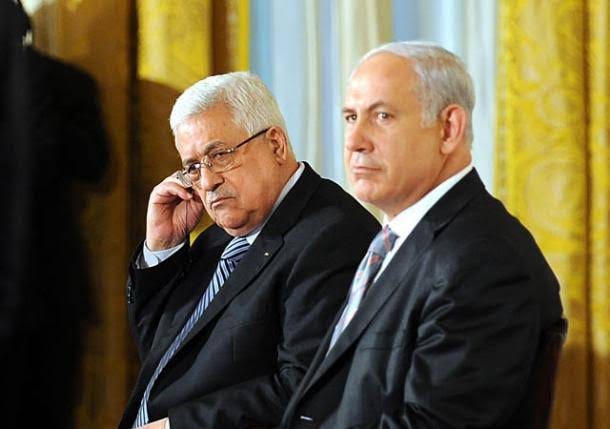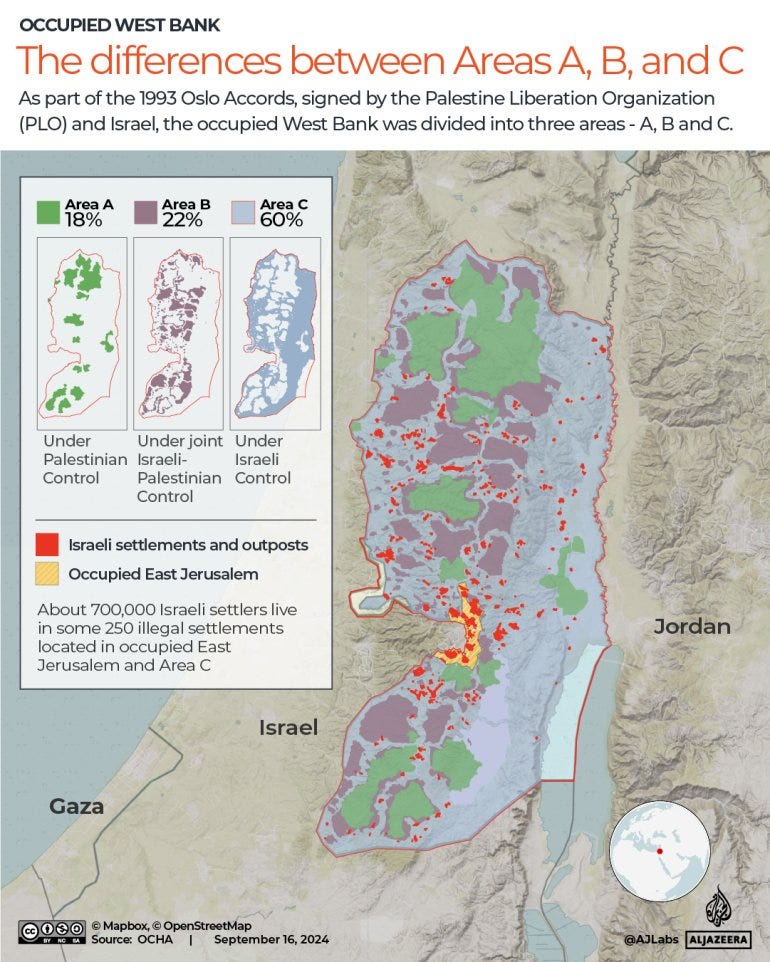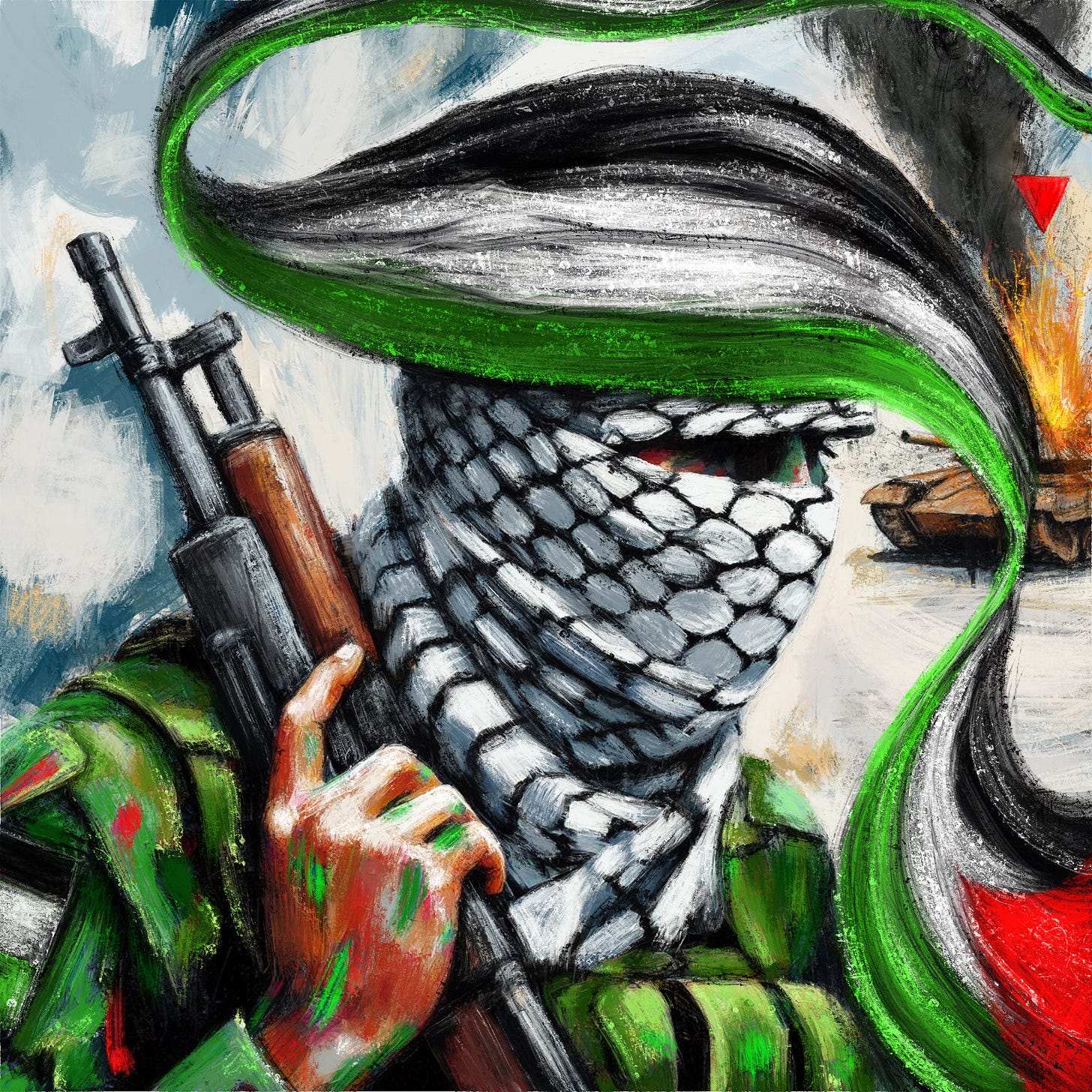The Colonial Subcontracting System
Israel and the Palestinian Authority
What does it mean when a colonial power assigns the work of domination to the very people it subjugates? Can such an arrangement ever produce freedom, or does it only refine occupation under the name of self-government?
The relationship between Israel and the Palestinian Authority (PA) exemplifies the logic of colonial subcontracting, like earlier colonial systems of indirect rule that delegated governance to local elites. The Oslo Accords and the Paris Protocol were hailed as the foundations of a Palestinian state. Instead, they produced its opposite: a fragmented land, an economy tied to dependency, and a PA made responsible for policing its own people on Israel’s behalf.
The Oslo Accords
Oslo was not a peace agreement but a political capitulation. Conducted in secret, the 1993 accord bypassed the collective achievements of the First Intifada and undercut the Palestinian committee in Madrid that was pursuing the political gains won through that uprising. In Oslo, Israel secured recognition from the PLO, while Palestinians received only the promise of limited self-administration, with no commitment to statehood, sovereignty, or the right of return. The central questions of settlements, refugees, and Jerusalem were deferred indefinitely, allowing Israel to expand its control under the cover of negotiation.
To implement this arrangement, the accords created the PA as a governing body in the occupied territories. Yasser Arafat and the Fatah leadership, returning from exile in Tunisia, assumed its helm—effectively transforming the PLO from a national liberation movement into a local administration under occupation. It was what Edward Said called a “Palestinian Versailles,” an agreement that exchanged the struggle for liberation with the privileges of authority under occupation.
The accords carved the West Bank into Areas A, B, and C, confining the PA to isolated enclaves of just 18%. Israel kept security control over Area B and full control over Area C—60% of the territory and nearly all its resources. What was announced as Palestinian self-rule was in reality Israeli rule by proxy, as settlements expanded and Israel tightened its hold on borders, water, and roads.
The fragmentation was not only territorial but psychological. By severing communities and restricting movement, Oslo dismantled the collective space necessary for resistance. Its system of “security coordination” bound the PA to suppress dissent and pursue resistance members, often in direct alignment with Israeli priorities.
In Jenin, for example, the PA moved against its own people under the banner of “Protect the Homeland,” showing how subcontracting turns the colonized into instruments of their own subjugation.
Economic Dependency: The Paris Protocol
The Paris Protocol, signed in 1994 as the economic arm of Oslo, bound the Palestinian economy to Israel. It deprived the PA of fiscal sovereignty by placing all customs duties and value-added taxes on goods destined for Palestinian markets in Israel’s hands. These revenues are transferred to the PA only at Israel’s discretion, withheld whenever it wishes to enforce compliance. What was presented as economic coordination has functioned instead as a system of coercion, turning livelihood itself into a tool of control.
In 2024, Israel’s Finance Minister Bezalel Smotrich deducted $26 million from Palestinian tax revenues, triggering a financial crisis that left thousands of public-sector workers without full salaries. It was not a deviation but the very rule of the system, reducing autonomy to appearance and using dependency as an instrument of punishment.
Colonial powers have long relied on such economic levers. By controlling livelihoods, they secure quiescence, enrich a small elite, and drive the majority into poverty and despair. The Paris Protocol reproduces this pattern in Palestine, where a privileged few benefit while unemployment and hopelessness spread. Far from preparing the ground for sovereignty, it institutionalizes subordination—ensuring that freedom remains structurally unattainable.
For Israel, the arrangement is both cost-effective and politically convenient. By outsourcing both civil administration and security to the PA, it avoids the costs of direct occupation and deflects international criticism. By controlling revenues through the Paris Protocol, it wields economic dependency as another form of discipline. Meanwhile, settlements expand and occupation deepens. What appears as progress toward statehood is in fact the refinement of domination.
From the First Intifada to Gaza’s Blockade
The Oslo and Paris accords were framed as the pathway to Palestinian statehood, but they were bookended by two moments that revealed a different story: the 1991 Madrid Peace Conference and the 2006 Palestinian legislative elections. Between them came the Second Intifada, which erupted in 2000 after the collapse of Oslo’s promises and disillusionment with the so-called peace process.
Madrid was the political fruit of the First Intifada, the uprising that forced global recognition of the Palestinian cause. For the first time, Israel was compelled to negotiate not out of goodwill but because the cost of resistance had become too high. But two years later in Oslo, that achievement was squandered in secret talks, as Arafat and the Fatah leadership traded the gains of the Intifada for their return from exile, political authority, and the symbols of statehood through the PA.
One of the major reasons for the Second Intifada was growing frustration with the Fatah-led PA, compounded by Israel’s relentless settlement expansion and Ariel Sharon’s 2000 visit to the Al-Aqsa Mosque compound, which ignited the uprising. It ended in 2005 under the weight of brutal repression, followed by Israel’s unilateral withdrawal of settlers and soldiers from Gaza and the dismantlement of 21 settlements there.
The following year, legislative elections were held. Widely regarded as transparent and fair, they produced a decisive victory for Hamas. Thirteen years after the signing of the Oslo Accords, the consequences of that bargain were undeniable: a popular rejection of the PA’s corruption, complicity, and failure. Instead of honoring the result, the United States, Israel, and the European Union moved instantly to nullify it, imposing sanctions on the Hamas-led government.
Under U.S. General Keith Dayton, PA security forces were armed and trained to confront Hamas, escalating tensions and fueling clashes. By 2007, Hamas had taken control of Gaza while Fatah consolidated its rule in the West Bank. The division became permanent, giving Israel the pretext to tighten its occupation and impose a blockade on Gaza that endures to this day.
The trajectory of the Palestinian national struggle could not have been clearer, beginning in Madrid with a hard-won recognition of rights, reduced in Oslo to subcontracted authority, and by 2006 fractured into rival administrations in Gaza and the West Bank.
At every stage, Israel has exploited these divisions to tighten its grip, treating Palestinian disunity as proof of their incapacity for self-rule. What is offered in place of genuine sovereignty is the appearance of choice: elections held under occupation, negotiations conducted without leverage, the trappings of authority without its substance.
And when those choices do not conform to Israel’s terms, they are dismissed outright, with Palestinian division invoked as evidence that there is no partner for peace. The result is a circular logic that entrenches domination: Israel manufactures fragmentation, exploits it to expand control, and then cites it as the reason why peace cannot be achieved.
The Only Path to Liberation
While Israel profits from this colonial system of subcontracted control, for Palestinians the costs are devastating. They face the double burden of resisting occupation while overcoming internal divisions that fracture the struggle itself. Political rivalry, driven by Fatah’s bid to preserve its authority and Hamas’s refusal to abandon resistance, has fractured the national cause.
The PA has accommodated the reality of occupation, displacement, and dispossession, parroting Western rhetoric about “peace” instead of resisting it. Hamas, by contrast, has held fast to the language and practice of liberation. These divisions weaken collective resistance and allow the system to persist.
Abolishing this proxy system of control is essential for Palestinian unity and liberation. The PA’s reliance on Israel, and its complicity in preserving the status quo, undermine the broader struggle for justice and self-determination. Coexistence under such a framework is impossible. What is called “reconciliation” is in fact submission misnamed as compromise, where the rhetoric of peace is weaponized to suppress resistance.
Freedom cannot be granted by the colonizer; it must be reclaimed. Neither the devastation of occupation nor the ongoing genocide has broken the determination of Gaza’s resistance. Despite siege, bombardment, and scarcity, fighters continue to confront Israel with persistence and resolve.
While the PA clings to its role as enforcer of the status quo, the resistance carries forward the struggle for liberation. The world may fail to recognize their worth, but Palestinians honor these fighters for their sacrifice, endurance, and devotion to land and people. Their struggle belongs to the same history in which the colonized refuse the roles imposed on them. The oppressed are not fated to manage their own subjugation—they will dismantle it.





🫡🫡